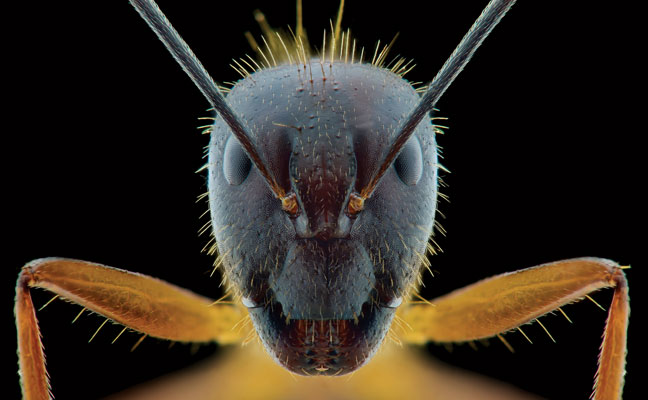
PHOTO: Getty Images: Dwi Yulianto/iStock / Getty Images Plus
Study: Starving Argentine ants are more cautious in search for food
A new study from the University of California – Los Angeles (UCLA) found that starving Argentine ants (Linepithema humile) were more cautious, not less, in their search for food.
Argentine ants have been able to displace native ant species in large part because of their aggressive foraging for sugar and other carbohydrates. However, when they’ve been deprived of food and competitors are present, they significantly limit their foraging activity instead of vigorously pursuing food. Overall, this strategy may provide a benefit to their colonies, researchers said.

An Argentine ant tends aphids, plant parasites that secrete the sugar-rich honeydew that the ants consume. PHOTO: UCLA / DR. NOA PINTER-WOLLMAN
It might seem like common sense that a starving animal is more likely to take dangerous risks to obtain food than one with a full belly. But this new research shows that groups of Argentine ants, which forage boldly when they’re well fed, exercise far more caution when they’ve been deprived of carbohydrates and the risks from competitors are high.
The UCLA researchers’ findings, published in the Nov. 12, 2022, issue of the journal Current Zoology, suggest the unwillingness of Argentine ants to expose themselves to danger when weakened by hunger could possibly give them a competitive edge over other species by helping preserve their colonies’ foraging capabilities.
Two established concepts lend credence to these findings:
- The asset-protection principle holds that hungry animals have less to lose than satiated animals and therefore will behave more assertively to get food.
- The state-dependent safety hypothesis holds that animals in good condition are more likely to take risks because they are more likely to survive dangers they encounter.
The work points toward an avenue of research that could lead to better efforts to control the spread of Argentine ants, the researchers said.
Venom is versatile in the world of RIFA
Agricultural Research Service (ARS) scientists from the agency’s Biological Control of Pests Research Unit and Southern Insect Management Research Unit in Stoneville, Miss., discovered a new way that red imported fire ants (Solenopsis invicta, or RIFA) use their venom to prevent diseases in their colonies.
Venom is associated with being harmful, but RIFA are using their venom for its medicinal benefits by sharing the toxic substance with their nestmates, according to a study published in the October 2022 issue of Journal of Insect Physiology.

Red imported fire ants may be using venom as a stomach settler within their colonies. PHOTO: Getty Images:19695866/iStock / Getty Images Plus
Venom has different functions for RIFA. They use venomous stings against intruders and immobilize their prey. They also take advantage of their venom’s antimicrobial properties in disease control by using it as an external surface disinfectant. Foraging ants encounter various pathogens in their environments. These pathogens threaten ants, especially when they share food with their nestmates. Thus, the ants use their venom as an “internal antibiotic” to ensure food fares well in their digestive systems.
In the study, researchers found nitrogenous organic compounds of venom, known as alkaloids, in crops and midguts of larvae. This finding indicates that trophallaxis — the transfer of food from mouth-to-mouth or mouth-to-anus feeding — must be involved in the transfer of venom because larvae do not produce alkaloids and depend on worker ants to be fed.
Researchers also found female RIFA alates (winged ants) shed their wings after mating flights, burrow into the soil, and start new colonies. Each new queen then provides venom alkaloids to her first batch of larvae in the colony. Then “minim” ant workers, defined as the first batch of workers in a RIFA colony, emerge and take over the role of providing venom to the larvae in the colony. The minim ant workers eventually die, and the normal ant workers then become the colony’s venom donors. Thus, venom sharing occurs in every stage of colony development.
As a social insect, in addition to individual immunity, RIFA have evolved social immunity based on the interaction among nestmates. This study indicates that venom sharing by feeding may be an essential component of RIFA social immunity. This research could help scientists better understand the ways ants work together to avoid epidemics.
Did you know?

PHOTO: Getty Image: apichat_naweewon/iStock / Getty Images Plus
Ant avengers
Is “ant midden” in your vocabulary? If not, it should be: It’s the term used to describe where ants carry their dead (as seen in the photo), waste and contamination, built to keep the risk of infections away from the colony.
As San Antonio, Texas-based Accurate Pest Control explains in a recent blog post, “When you squash an ant, the fluids release pheromones, which will signal danger to the ants in the vicinity. When the investigation group comes across the dead, they return to the [colony] and relay vital information. It triggers a response, and you will end up seeing a lot more ants who arrive at the location of the dead to get them back to the midden.” The process is known as necrophoresis, and also happens among other social insects.
Little fire ants widen range
With some populations in California, Florida and Hawaii, among elsewhere worldwide, the little fire ant (Wasmannia auropunctata) was first detected in American Samoa in late 2018. Less than five years later, researchers predict this stinging pest could disrupt ecosystems across the U.S. territory.
This ant’s ability to forage and nest in a variety of areas poses problems for people, pets, livestock and crops, so the U.S. Department of Agriculture’s National Institute of Food and Agriculture has begun a three-year program in American Samoa, tracking its range and which control treatments work best.
Leave A Comment